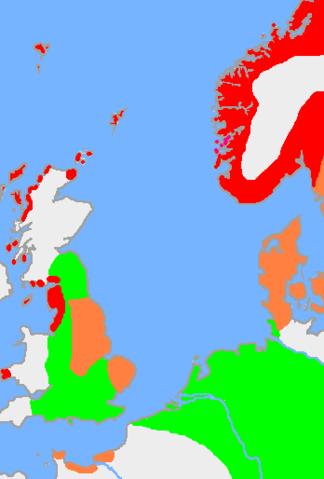 |
This is a file from the Wikimedia Commons. Information from its description page there is shown below.
Commons is a freely licensed media file repository. You can help.
|
This is part of the commons-picture Image:Old norse, ca 900.PNG focused on the North Sea.
This is the approximate extent of Old Norse and related languages in the early 10th century around the North Sea. The red area is the distribution of the dialect Old West Norse, the orange area is the spread of the dialect Old East Norse and the green area is the extent of the other Germanic languages with which Old Norse still retained some mutual intelligibility
w:User:Wiglaf made the original map, based on Image:Europe plain rivers.png, a blank map by User:Dbachmann.
Sources: Nationalencyklopedin and The Harper Atlas of World History (ed. Vidal-Naquet) in Swedish translation: Atlas över mänsklighetens historia.
Uploaded to en: by Wiglaf on April 20, 2005 and licensed under GFDL.
 |
Permission is granted to copy, distribute and/or modify this document under the terms of the GNU Free Documentation License, Version 1.2 or any later version published by the Free Software Foundation; with no Invariant Sections, no Front-Cover Texts, and no Back-Cover Texts.
Subject to disclaimers.www.gnu.org/copyleft/fdl.htmlGFDLGNU Free Documentation Licensetruetrue
|
File usage
The following pages on Schools Wikipedia link to this image (list may be incomplete):
Schools Wikipedia has made the best of Wikipedia available to students. SOS Childrens Villages works in 133 countries and territories across the globe, helps more than 62,000 children, and reaches over 2 million people in total. If you'd like to help, why not learn how to sponsor a child?



